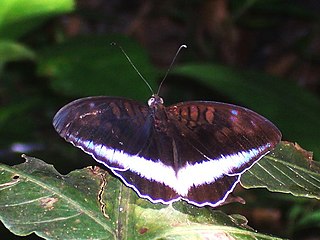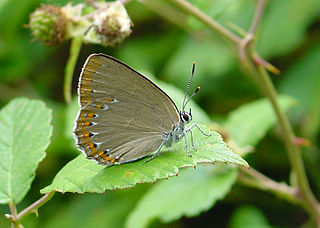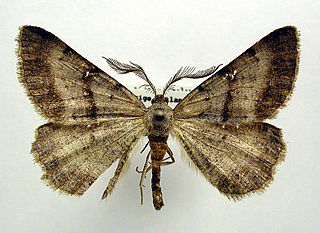
The goldenrod pug is a moth of the family Geometridae. The species was first described by Henry Doubleday in 1861. It is found throughout the Palearctic region. In the British Isles it is widespread but rather locally distributed.

The juniper pug or juniper looper is a moth of the family Geometridae. The species was first described by Michael Denis and Ignaz Schiffermüller in 1775. It is found throughout the Palearctic and in the Nearctic.

The Limenitidinae are a subfamily of butterflies that includes the admirals and relatives. The common names of many species and genera reference military ranks or – namely the Adoliadini – titles of nobility, in reference to these butterflies' large size, bold patterns, and dashing flight. In particular, the light stripe running lengthwise across the wings of many Limenitidini has reminded earlier authors of officers' shoulder marks and epaulets.

Pachliopta atropos is a species of butterfly in the family Papilionidae. It is endemic to the Philippines.

Laeosopis is a monotypic butterfly genus in the family Lycaenidae. Its only species is Laeosopis roboris, the Spanish purple hairstreak, which is found on the Iberian Peninsula and south-eastern France.

Cyclophora albipunctata, the birch mocha, is a moth of the family Geometridae. The species was first described by Johann Siegfried Hufnagel in 1767. It is found in the Palearctic. The southern boundary runs westward along the French Atlantic coast and to the British Isles and north of the Alps. In the east, the species ranges to the Pacific Ocean. South of the northern Alps line, it is found at some high elevation areas and mountains. In the Pyrenees, the Massif Central, the southern Alps, the northern Dinaric Alps, in the western and northern Carpathians, in northern Turkey and the Caucasus. In the north, the range extends up to the Arctic Circle. In the Far East the nominate subspecies is replaced by Cyclophora albipunctata griseolataStaudinger, 1897.

Calliteara pudibunda, the pale tussock, is a moth of the family Erebidae. The Dutch common name for the moth (Meriansborstel) comes from the butterfly and insect painter Maria Sibylla Merian. The species was first described by Carl Linnaeus in his 1758 10th edition of Systema Naturae. It is found in Asia and Europe.

Allophyes oxyacanthae, the green-brindled crescent, is a moth of the family Noctuidae, found in Europe. The species was described by Carl Linnaeus in his landmark 1758 10th edition of Systema Naturae.

Chazara briseis, the hermit, is a butterfly species belonging to the family Nymphalidae. It can be found in North Africa, southern Europe, Asia Minor, the Caucasus, Kazakhstan, Central Asia through Afghanistan, and north-western China and Tuva. It is found on steppe and in other dry grassy places between 500 and 2,500 meters.

Epirrhoe galiata, the galium carpet, is a moth of the family Geometridae.

Selidosema brunnearia, the bordered grey, is a moth of the family Geometridae. The species was first described by Charles Joseph Devillers in 1789. It is found in central and southern Europe, Asia Minor, Transcaucasia and North Africa.

Charaxes monteiri is a rare tropical butterfly of the family Nymphalidae, belonging to the Charaxinae subfamily or leafwing butterflies. It was described by Otto Staudinger in 1885.
Eupithecia accurata is a moth in the family Geometridae. It is found in Turkmenistan, Uzbekistan, northern Iran and Kazakhstan.
Scoparia antarcticalis is a moth in the family Crambidae. It was described by Otto Staudinger in 1899. It is found in Patagonia.
Nothris sulcella is a moth in the family Gelechiidae. It was described by Otto Staudinger in 1859. It is found in Asia Minor.
Pogochaetia solitaria is a moth in the family Gelechiidae. It was described by Otto Staudinger in 1880. It is found in Spain, France, Italy, Switzerland, Austria, Greece, Turkey and northern Iran.

Dichagyris renigera is a moth of the family Noctuidae. It is found in South- and Southeast-Europe, Armenia, Caucasus and Turkey.

Haemerosia renalis is a moth of the family Noctuidae. It was described by Jacob Hübner in 1813. It is found in Spain, France, Italy, Sicily, Bosnia and Herzegovina, Serbia, Croatia, Slovenia, Bulgaria, North Macedonia and Greece. It has also been recorded from the Near East.













